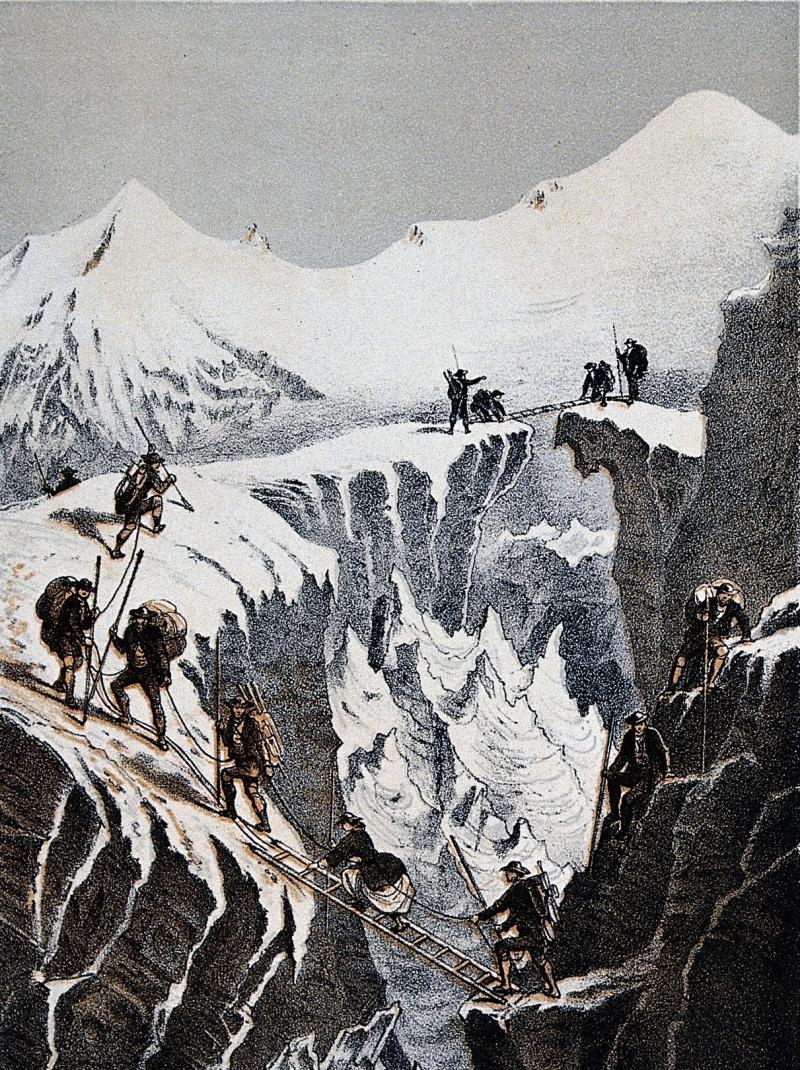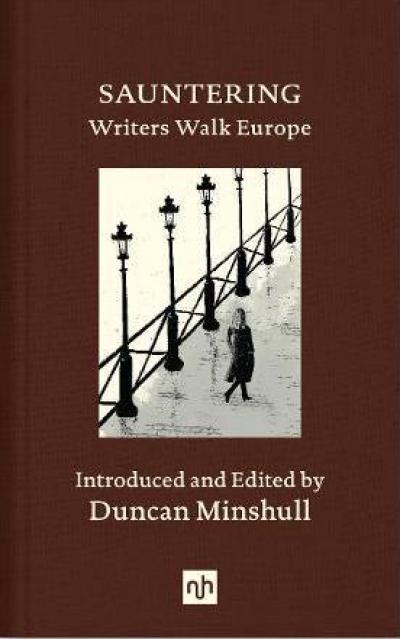Extract from Sauntering: Writers Walk Europe, introduced and edited by Duncan Minshull | reviews, news & interviews
Extract from Sauntering: Writers Walk Europe, introduced and edited by Duncan Minshull
Extract from Sauntering: Writers Walk Europe, introduced and edited by Duncan Minshull
An ode to leisurely aimlessness

Wandering, ambling, sauntering. The last, least heard of the three, captures a sense of leisurely aimlessness: a jolly meander unbound by destination, admitting none of the qualms of timekeeping or pacing.
"I walked through the mountains today", says Robert Walser, Swiss-born, Alps-besotted, and taking to the road to "see so much". He encounters smoking trains, fellow hikers and highway children, and all becomes "an enormous theatre" to him. A theatre of walking types is what struck me as I sorted these extracts, with Europe acting as the mis-en-scene. Ex-pat authors, pilgrims and paraders have passed so far. Who else shall show?
Questing types for certain. Walking to a place is often a quest, different to a pilgrimage. Up, up into the thinning air goes Henriette D’Angeville, the second woman to reach the top of Mont Blanc. She’s not against the men of the team, but she won’t be helped by them either, even as her strides turn to stumbles and the endeavour looks doomed. Nor would you call D’Angeville a poet of the peaks, yet her words affirming success at "twenty five past one" on a September afternoon ring clear – bravo to that. And a more recent quester is Joanna Kavenna, setting off to find the mythical land of Thule. Approaching the glacial tongue of Skaftafellsjokull (Iceland), she appreciates the walker’s tininess against an expanse of white. The ice doesn’t cause fear, it hints at "incongruity". Small details are telling, as are her words to describe the writings of an earlier visitor – Richard Burton’s "holiday baroque".

Words come easily en route. Physical movement frees the mind, stirs up thoughts and this leads to a brilliant insight or two. Immanuel Kant’s walking habit is just that – a habit – and he probably sensed little of the external world when pacing a lime-tree avenue in Konigsberg, northern Germany. He was so precise in his practice – exactly eight lengths daily – that his neighbours would set their watches by him. But unknown to them "what destroying, world-crushing thoughts and words" were being hatched there, under the limes, according to Kant’s chronicler Henrich Heine.
Thoughts also come to Ludwig van Beethoven, in the Vienna Woods. And the more he walks, he says, the more likely these thoughts shall turn to "tones", then to "notes". It’s tempting to believe melodies for the Sixth Symphony (The Pastoral) were honed this way as he weaved amongst the trees, and set a rhythm. Likewise, evening strolls along the front at Nice provide artist Maria Bashkirtseff with images to use for a series of canvases, including an entry from her diary, almost fully realised – "the moon is shining on that interminable road on the sea, which looks like a fish with diamond scales".
These walks around Europe encourage another imaginative act – that of reclaiming and reshaping the past. Yes, Edith Wharton steps forward to step back, being attuned to the ages of Sicily. One night her friend Joseph Conrad revisits Cracow with his eldest son in tow. Familiar buildings loom large to convey a pleasing "unchangeableness" – and carry the father back too. But a jarring discovery is made at "Line A.B", a place cherished by Conrad at an age the son is now. Unreliable memories are playing their tricks, and the two figures resume their stroll further into the gaslit gloom.
[…]
In Sauntering I hope you find a favourite city – seen and sensed at pavement level. It might be London or Antwerp; Seville or Vienna; Prague or Florence. Each wonderfully walkable, yet the French capital shines for me, with its specific moods and allure, its compactness, and sheer variety of connecting thoroughfares. And Paris provides that "enormous theatre" in the pages ahead. Watch out for the flaneurs, for an original "psycho-geographer", and for one deemed unclassifiable – "Who is the peculiar man?", asks Rainer Maria Rilke, as he trails him beyond Place St Michel, never expecting an answer to the question.
- SAUNTERING: Writers Walk Europe, Introduced and Edited by Duncan Minshull (Notting Hill Editions, £14.99)
The future of Arts Journalism
You can stop theartsdesk.com closing!
We urgently need financing to survive. Our fundraising drive has thus far raised £49,000 but we need to reach £100,000 or we will be forced to close. Please contribute here: https://gofund.me/c3f6033d
And if you can forward this information to anyone who might assist, we’d be grateful.

Subscribe to theartsdesk.com
Thank you for continuing to read our work on theartsdesk.com. For unlimited access to every article in its entirety, including our archive of more than 15,000 pieces, we're asking for £5 per month or £40 per year. We feel it's a very good deal, and hope you do too.
To take a subscription now simply click here.
And if you're looking for that extra gift for a friend or family member, why not treat them to a theartsdesk.com gift subscription?
more Books
 'We are bowled over!' Thank you for your messages of love and support
Much-appreciated words of commendation from readers and the cultural community
'We are bowled over!' Thank you for your messages of love and support
Much-appreciated words of commendation from readers and the cultural community
 Justin Lewis: Into the Groove review - fun and fact-filled trip through Eighties pop
Month by month journey through a decade gives insights into ordinary people’s lives
Justin Lewis: Into the Groove review - fun and fact-filled trip through Eighties pop
Month by month journey through a decade gives insights into ordinary people’s lives
 Joanna Pocock: Greyhound review - on the road again
A writer retraces her steps to furrow a deeper path through modern America
Joanna Pocock: Greyhound review - on the road again
A writer retraces her steps to furrow a deeper path through modern America
 Mark Hussey: Mrs Dalloway - Biography of a Novel review - echoes across crises
On the centenary of the work's publication an insightful book shows its prescience
Mark Hussey: Mrs Dalloway - Biography of a Novel review - echoes across crises
On the centenary of the work's publication an insightful book shows its prescience
 Frances Wilson: Electric Spark - The Enigma of Muriel Spark review - the matter of fact
Frances Wilson employs her full artistic power to keep pace with Spark’s fantastic and fugitive life
Frances Wilson: Electric Spark - The Enigma of Muriel Spark review - the matter of fact
Frances Wilson employs her full artistic power to keep pace with Spark’s fantastic and fugitive life
 Elizabeth Alker: Everything We Do is Music review - Prokofiev goes pop
A compelling journey into a surprising musical kinship
Elizabeth Alker: Everything We Do is Music review - Prokofiev goes pop
A compelling journey into a surprising musical kinship
 Natalia Ginzburg: The City and the House review - a dying art
Dick Davis renders this analogue love-letter in polyphonic English
Natalia Ginzburg: The City and the House review - a dying art
Dick Davis renders this analogue love-letter in polyphonic English
 Tom Raworth: Cancer review - truthfulness
A 'lost' book reconfirms Raworth’s legacy as one of the great lyric poets
Tom Raworth: Cancer review - truthfulness
A 'lost' book reconfirms Raworth’s legacy as one of the great lyric poets
 Ian Leslie: John and Paul - A Love Story in Songs review - help!
Ian Leslie loses himself in amateur psychology, and fatally misreads The Beatles
Ian Leslie: John and Paul - A Love Story in Songs review - help!
Ian Leslie loses himself in amateur psychology, and fatally misreads The Beatles
 Samuel Arbesman: The Magic of Code review - the spark ages
A wide-eyed take on our digital world can’t quite dispel the dangers
Samuel Arbesman: The Magic of Code review - the spark ages
A wide-eyed take on our digital world can’t quite dispel the dangers
 Zsuzsanna Gahse: Mountainish review - seeking refuge
Notes on danger and dialogue in the shadow of the Swiss Alps
Zsuzsanna Gahse: Mountainish review - seeking refuge
Notes on danger and dialogue in the shadow of the Swiss Alps
 Patrick McGilligan: Woody Allen - A Travesty of a Mockery of a Sham review - New York stories
Fair-minded Woody Allen biography covers all bases
Patrick McGilligan: Woody Allen - A Travesty of a Mockery of a Sham review - New York stories
Fair-minded Woody Allen biography covers all bases

Add comment